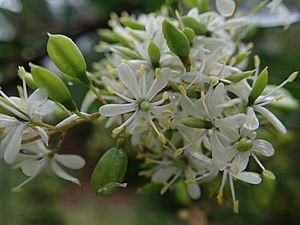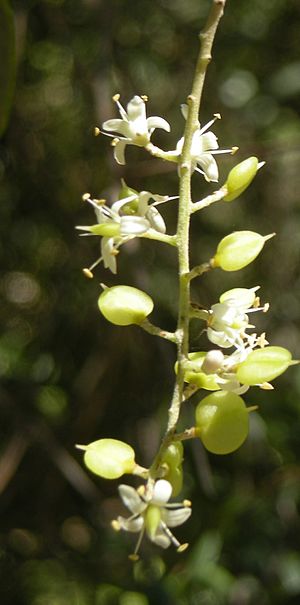Bursaria spinosa facts for kids
Quick facts for kids Bursaria spinosa |
|
|---|---|
 |
|
| Scientific classification | |
| Genus: |
Bursaria
|
| Species: |
spinosa
|
| Synonyms | |
|
|
Bursaria spinosa is a type of small tree or shrub that belongs to the Pittosporaceae plant family. You can find this plant mostly in the eastern and southern parts of Australia. It does not grow in Western Australia or the Northern Territory. This plant can grow up to 10 meters (35 feet) tall. It has sweet-smelling white flowers that can bloom at any time of the year, but especially in summer.
Bursaria spinosa is a common plant found under taller trees in eucalyptus forests. It often grows in areas where the land has been disturbed or on old farmland. It is also a very important food source for many types of butterflies and moths, especially those from the Paralucia group, and for native bees.
Contents
Discovering and Naming the Sweet Bursaria
The Bursaria spinosa plant was first found by Europeans near Port Jackson in Australia. A scientist named Antonio José Cavanilles officially described it in 1797. This plant has many common names. Some people call it Australian blackthorn, blackthorn, or Christmas bush. Other names include mock orange, native blackthorn, and sweet bursaria.
In Tasmania and South Australia, it is sometimes called Christmas bush because its flowers bloom in summer, which is Christmas time there. (But don't confuse it with another plant called Prostanthera lasianthos). Indigenous people also have names for it, like kurwan in Coranderrk, Victoria, and geapga from Lake Hindmarsh Station.
Different Kinds of Sweet Bursaria
Bursaria spinosa can look very different from one plant to another. Scientists have tried to classify these differences many times. In 1839, an Austrian botanist named Aloys Putterlick divided Bursaria spinosa into two main types: one with spines (spinosa) and one without spines (inermis).
Later, in 1999, scientists looked at the plant again. They decided there are only two main subspecies. One of these, B. spinosa lasiophylla, was once thought to be a completely separate species.
So, the subspecies spinosa is usually a 5–10 meter tall shrub or tree. It grows widely across eastern Australia and Tasmania. You can find it from the Eyre Peninsula in South Australia all the way to north Queensland. The other subspecies, lasiophylla, has shorter, wider leaves and smaller flowers. It only grows up to 5 meters tall. This type is found in southeastern Australia, like eastern South Australia and southern New South Wales, especially in areas with heavier clay soils.
What Does Sweet Bursaria Look Like?
The Bursaria spinosa plant can grow to different heights, from 1 to 12 meters tall. Its dark grey bark has grooves in it. The branches are smooth and sometimes have thorns. The leaves grow in different ways along the stems or in groups. They have a smell like pine trees when you crush them.
The leaves can be long and thin, oval, or wedge-shaped. They are usually 2–4.3 centimeters long and 0.3–1.2 centimeters wide. The end of the leaf is usually rounded. The flowers smell nice and can appear at any time of the year, but mostly in summer. They grow in groups that look like pyramids.
Where Sweet Bursaria Grows
In the Sydney area, Bursaria spinosa grows in soils made of clay and shale. It often grows under taller trees like grey box (Eucalyptus moluccana) and forest red gum (E. tereticornis). It also grows with a grass called Themeda australis. If farmland is not grazed by animals, this plant can form thick patches.
In Tasmania, it grows a lot on rocky hills where the soil is shallow. It is found among open eucalyptus forests and grasslands on the east coast and in the Midlands regions. Around Hobart and in the Southern Midlands, it grows widely on open slopes. Here, it forms large groups of short, bushy plants in grazing areas.
Life of the Sweet Bursaria
Bursaria spinosa can live for 25 to 60 years. After a bushfire, it can grow back from its woody base. The plants often spread underground using special roots called rhizomes. This means that many plants in one area might actually be part of a single, giant plant! Even if they are genetically the same, different parts of the plant can look very different. For example, some shoots might not have spines, even if the rest of the plant does. Its seeds are carried by the wind, and it is one of the first plants to grow in new or disturbed areas.
Insects and Animals that Visit Sweet Bursaria
Many different insects visit the flowers of Bursaria spinosa. The most important insects for pollination (helping the plant make seeds) seem to be beetles. Scientists have seen many types of beetles visiting the flowers around Armidale. These include jewel beetles like Curis splendens and Stigmodera inflata. Also, longhorn beetles such as Amphirhoe sloanei and Tropocalymma dimidiatum visit the flowers. Other visitors include scarab beetles and tumbling flower beetles. Beetles and scoliid wasps carry a lot of pollen from the flowers. Other insects like flies and butterflies carry less pollen.
The larvae (young insects) of the jewel beetle Astraeus crassus live in tunnels inside dead or dying branches of the plant. Some caterpillars also eat Bursaria spinosa leaves. These include Proselena annosana, the two-ribbed arctiid (Palaeosia bicosta), and the bark looper moth (Ectropis subtinctaria). The caterpillars of the clouded footman (Anestia ombrophanes) eat algae and lichens that grow on the branches.
Butterflies and Ants Working Together
The bright copper butterfly (Paralucia aurifera) and a type of ant called Anonychomyrma nitidiceps have a special partnership on Bursaria spinosa. The butterflies lay their eggs on the underside of the leaves. The caterpillars then eat the leaves. When they are ready to change into butterflies, they go into the soil at the bottom of the plant. The ants dig little rooms in the soil where the caterpillars sleep and later turn into pupae. The ants even go with the caterpillars when they are eating. Scientists think the ants feed on special liquids that the caterpillars produce.
Another butterfly, the fiery copper (Paralucia pyrodiscus), also has ants (from the group Notoncus) that go with its caterpillars. The third type, the endangered Bathurst copper (Paralucia spinifera), also lives and feeds only on the lasiophylla subspecies of Bursaria spinosa in Central New South Wales.
Young Bursaria spinosa plants are sometimes eaten by cattle and rabbits.
How People Use Sweet Bursaria
A special chemical called aesculin can be found in the plant in the Sydney region. Even though its thorns can make it tricky to grow in gardens, Bursaria spinosa is very useful. It provides sweet nectar for butterflies and a safe home for small birds.
See also
 In Spanish: Bursaria spinosa para niños
In Spanish: Bursaria spinosa para niños



